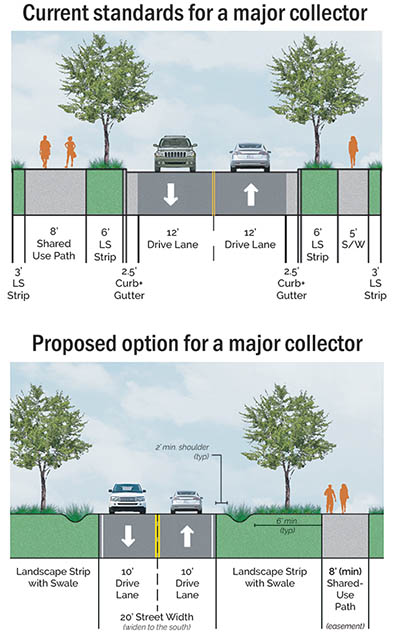Planning road improvements that retain character
from the Town by Wendy Smith

Farragut was founded on the desire to have control over development standards. We didn’t want our subdivisions to flood and we didn’t want to be surrounded by big box stores and billboards. Because of this desire for higher standards, the Town has adopted standards for roads. When roads are improved, certain elements must be included to enhance safety and provide for different modes of transportation (walking and bicycling).
Road projects are long and expensive, so planning for them begins years before the construction crew shows up. It starts with a simple map. Farragut’s Major Road Plan, which can be found at townoffarragut.org/maps, shows major and minor arterials and major and minor collectors – classifications based on the kind of traffic served by each road.
Arterials take traffic to other areas. Kingston Pike and Campbell Station Road are
arterials; drivers use them to get to another part of Knox County or to the interstate. Collectors also could be called connectors. They connect residential areas to arterials. When these roads are improved, they are improved to standards based on their classification.
Community Development director Mark Shipley knows that Farragut will continue to grow as large parcels of
property pass to the next generation and heirs opt to sell to developers. When that happens, developers are required to improve the road that fronts the new subdivision to the minimum standards for its classification. For example, major collectors require 12-foot lanes with curb and gutter and pedestrian facilities on both sides of the road. That’s a lot of hardscape, Mark said.
Instead, he’d like Farragut to have specific standards for each road on the Major Road Plan. For example, a road that’s improved with 10-foot lanes, open drainage and a shared use path on one side would allow some areas to retain a more rural character. For that to be an option, new standards for each road on the road plan would need to be adopted by the Town.
“To me, this is a huge benefit to property owners because otherwise, when a parcel develops, the road will be improved to current Town standards,” he said. “If we approve these alternative standards, it would lessen the amount of hardscape and allow us to add trees, capturing that rural character.”
Looking ahead to future development is part of the job of a planner. One task of the Farragut Community Development Department is considering where future development is likely to occur, both within Town boundaries and outside of Farragut. Planning for roads that can safely handle future traffic does not signal the beginning of a project; it’s thoughtful preparation for the coming years.
“The reality is that Farragut is a growing community and someday these streets are likely to be improved,” Mark said. “Good planning will allow those roads to retain the character that residents value.”
Want to stay informed about decisions that are being made by Farragut government? Sign up for Agenda Alerts at townoffarragut.org/agendas.


